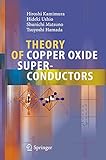Theory of Copper Oxide Superconductors / by Hiroshi Kamimura, Hideki Ushio, Shunichi Matsuno, Tsuyoshi Hamada.
Tipo de material: TextoEditor: Berlin, Heidelberg : Springer Berlin Heidelberg, 2005Descripción: x, 214 páginas 109 ilustraciones recurso en líneaTipo de contenido:
TextoEditor: Berlin, Heidelberg : Springer Berlin Heidelberg, 2005Descripción: x, 214 páginas 109 ilustraciones recurso en líneaTipo de contenido: - texto
- computadora
- recurso en línea
- 9783540276326
- QC611.9-611.98
Springer eBooks
Experimental Results of High Temperature Superconducting Cuprates -- Brief Review of Models of High-Temperature Superconducting Cuprates -- Cluster Models for Hole-Doped CuO6 Octahedron and CuO5 Pyramid -- MCSCF-CI Method: Its Application to a CuO6 Octahedron Embedded in LSCO -- Calculated Results of a Hole-Doped CuO5 Pyramid in YBa2Cu3O7?? -- Electronic Structure of a CuO5 Pyramid in Bi2Sr2CaCu2O8+? -- The Kamimura—Suwa (K-S) Model: Electronic Structure of Underdoped Cuprates -- Exact Diagonalization Method to Solve the K—S Hamiltonian -- Mean-Field Approximation for the K—S Hamiltonian -- Calculated Results of Many-Electrons Band Structures and Fermi Surfaces -- Normal State Properties of La2?xSrxCuO4 -- Electron—Phonon Interaction and Electron—Phonon Spectral Functions -- Mechanism of High Temperature Superconductivity.
This is an advanced textbook for graduate students and researchers wishing to learn about high temperature superconductivity in copper oxides, in particular the Kamimura-Suwa (K-S) model. Because a number of models have been proposed since the discovery of high temperature superconductivity by Bednorz and Müller in 1986, the book first explains briefly the historical development that led to the K-S model. It then focuses on the physical background necessary to understand the K-S model and on the basic principles behind various physical phenomena such as electronic structures, electrical, thermal and optical properties, and the mechanism of high temperature superconductivity.
Para consulta fuera de la UANL se requiere clave de acceso remoto.


